高二英语课堂教学设计案例
- 格式:doc
- 大小:68.50 KB
- 文档页数:11
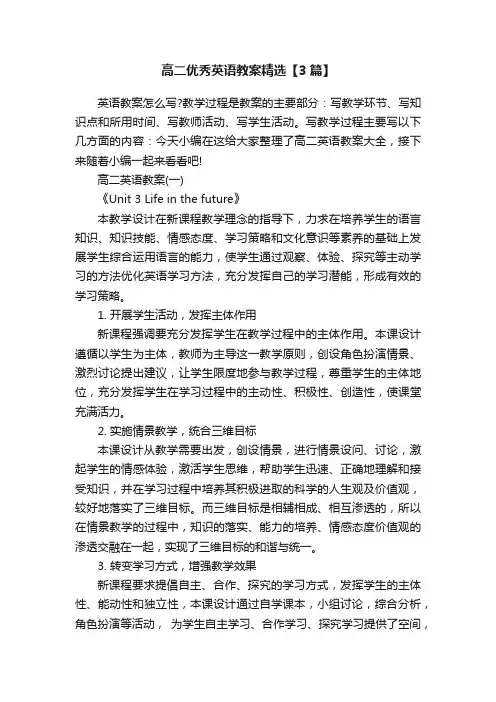
高二优秀英语教案精选【3篇】英语教案怎么写?教学过程是教案的主要部分:写教学环节、写知识点和所用时间、写教师活动、写学生活动。
写教学过程主要写以下几方面的内容:今天小编在这给大家整理了高二英语教案大全,接下来随着小编一起来看看吧!高二英语教案(一)《Unit 3 Life in the future》本教学设计在新课程教学理念的指导下,力求在培养学生的语言知识、知识技能、情感态度、学习策略和文化意识等素养的基础上发展学生综合运用语言的能力,使学生通过观察、体验、探究等主动学习的方法优化英语学习方法,充分发挥自己的学习潜能,形成有效的学习策略。
1. 开展学生活动,发挥主体作用新课程强调要充分发挥学生在教学过程中的主体作用。
本课设计遵循以学生为主体,教师为主导这一教学原则,创设角色扮演情景、激烈讨论提出建议,让学生限度地参与教学过程,尊重学生的主体地位,充分发挥学生在学习过程中的主动性、积极性、创造性,使课堂充满活力。
2. 实施情景教学,统合三维目标本课设计从教学需要出发,创设情景,进行情景设问、讨论,激起学生的情感体验,激活学生思维,帮助学生迅速、正确地理解和接受知识,并在学习过程中培养其积极进取的科学的人生观及价值观,较好地落实了三维目标。
而三维目标是相辅相成、相互渗透的,所以在情景教学的过程中,知识的落实、能力的培养、情感态度价值观的渗透交融在一起,实现了三维目标的和谐与统一。
3. 转变学习方式,增强教学效果新课程要求提倡自主、合作、探究的学习方式,发挥学生的主体性、能动性和独立性,本课设计通过自学课本,小组讨论,综合分析,角色扮演等活动,为学生自主学习、合作学习、探究学习提供了空间,使学生体验了自主之乐,合作之趣,探究之悦,促进了学生知识的构建与运用,能力的培养和提高,情感体验和态度、价值观的形成,增强了教学效果。
4. 运用问题教学,启发学生思维本课设计按照诱思探究理论要求,遵循学生的认知规律,引导学生去发现问题、分析问题和解决问题,从而掌握知识,形成能力,培养品质。
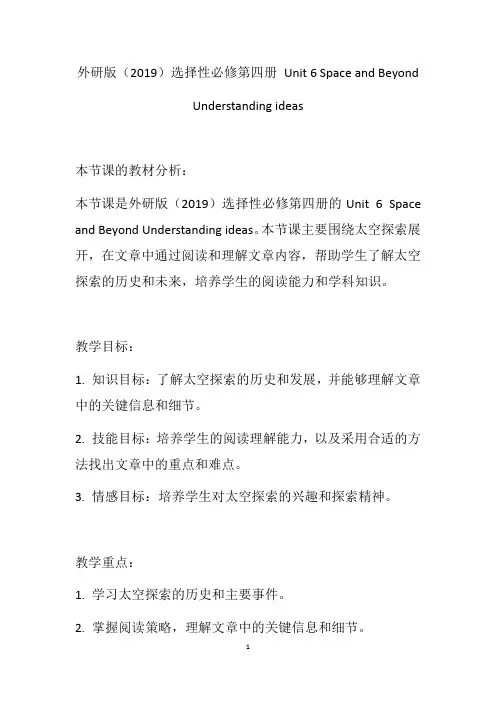
外研版(2019)选择性必修第四册Unit 6 Space and BeyondUnderstanding ideas本节课的教材分析:本节课是外研版(2019)选择性必修第四册的Unit 6 Space and Beyond Understanding ideas。
本节课主要围绕太空探索展开,在文章中通过阅读和理解文章内容,帮助学生了解太空探索的历史和未来,培养学生的阅读能力和学科知识。
教学目标:1. 知识目标:了解太空探索的历史和发展,并能够理解文章中的关键信息和细节。
2. 技能目标:培养学生的阅读理解能力,以及采用合适的方法找出文章中的重点和难点。
3. 情感目标:培养学生对太空探索的兴趣和探索精神。
教学重点:1. 学习太空探索的历史和主要事件。
2. 掌握阅读策略,理解文章中的关键信息和细节。
教学难点:1. 学生对太空探索的历史和发展存在较少知识基础,理解难度较大。
2. 学生可能会遇到一些较为抽象和难以理解的概念。
学情分析:学生为高二学生,已具备较强的英语听、说、读、写能力。
然而,学生对太空探索的知识可能了解较少,对该主题的理解相对较浅。
因此,本节课需要注重学生的背景知识的介绍和讲解,同时在阅读理解过程中引导学生结合上下文去理解抽象概念。
教学策略:1. 激发学生的学习兴趣,通过引入太空探索中的有趣事件和发现来吸引学生的注意力。
2. 设立问题导向,通过让学生在阅读过程中自主寻找关键信息来激发学生的思考和分析能力。
3. 引导学生进行合作学习,通过小组合作讨论、概念澄清和信息整合来加深学生对文章内容的理解。
教学方法:1. 多媒体展示法:通过图片、视频等多媒体提供相关背景知识。
2. 阅读方法:采用快速阅读和细节阅读相结合的方法,帮助学生有效获取文章的主要信息和细节。
3. 合作学习法:通过小组合作学习,让学生在互动中共同解决问题,提高学习效果。
导入环节(约5分钟):教学内容:导入学生对太空和宇宙的基础知识教学活动:在黑板上画出太空和宇宙的图示,然后与学生进行互动问答,引导学生思考和回顾他们已经学到的关于太空和宇宙的知识。
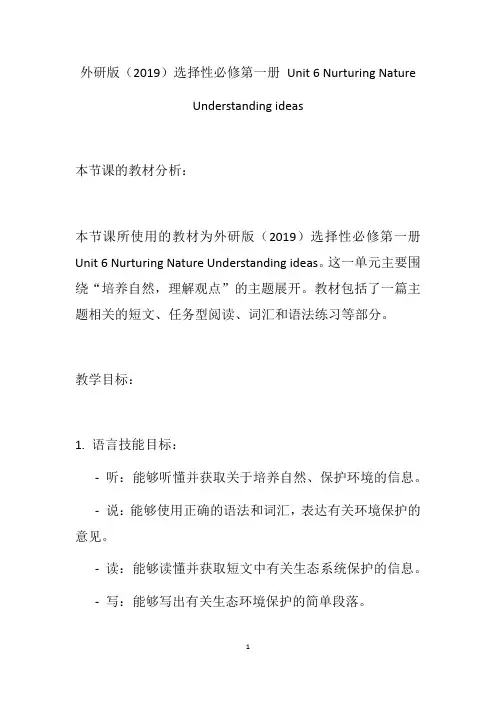
外研版(2019)选择性必修第一册Unit 6 Nurturing NatureUnderstanding ideas本节课的教材分析:本节课所使用的教材为外研版(2019)选择性必修第一册Unit 6 Nurturing Nature Understanding ideas。
这一单元主要围绕“培养自然,理解观点”的主题展开。
教材包括了一篇主题相关的短文、任务型阅读、词汇和语法练习等部分。
教学目标:1. 语言技能目标:-听:能够听懂并获取关于培养自然、保护环境的信息。
-说:能够使用正确的语法和词汇,表达有关环境保护的意见。
-读:能够读懂并获取短文中有关生态系统保护的信息。
-写:能够写出有关生态环境保护的简单段落。
2. 知识技能目标:-了解生态系统的定义和特征。
-掌握与生态系统保护相关的常用词汇和表达方式。
-学会使用语法结构“Thanks to + 名词/代词/动词不定式”表达感激之情。
教学重点:1. 学会使用语法结构“Thanks to + 名词/代词/动词不定式”表达感激之情。
2. 掌握与生态系统保护相关的常用词汇和表达方式。
教学难点:学会通过任务型阅读了解生态系统的特点,能够表达对保护环境的意见。
学情分析:本节课的内容与学生的生活经验和学科知识有较大的关联,学生对环境问题也有一定的认识。
大多数学生对于生态系统并不了解,需要通过教材的引导来帮助理解并培养对自然的关注。
同时,学生对于语法结构的掌握情况不一,对于新的词汇和表达方式也需要进行适当的引导和训练。
教学策略:1. 激发学生的学习兴趣:通过引入真实环境问题和相关视频素材,激发学生对课程主题的兴趣。
2. 合作学习:组织学生进行小组合作学习,共同完成任务型阅读和课堂讨论,培养学生合作和交流的能力。
3. 多样化教学手段:运用图片、视频、音频等多种形式的教学手段,以激发学生的多感官参与,提高学习效果。
教学方法:1. 观察法:通过展示图片和视频,引导学生观察自然环境中的生态现象,激发学生对环境保护的兴趣和思考。
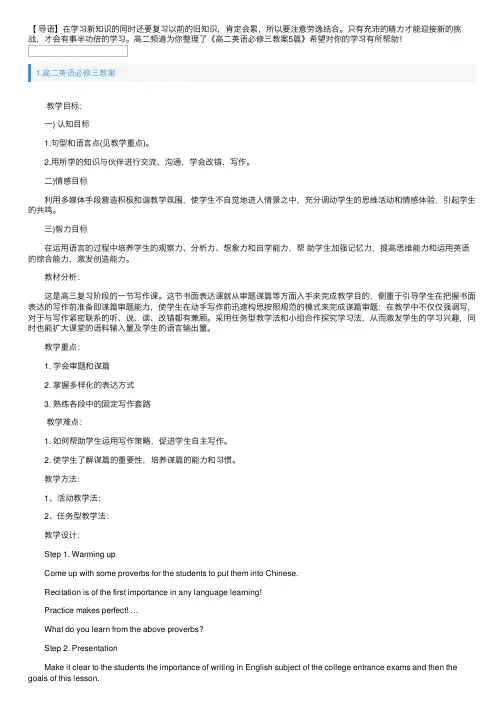
【导语】在学习新知识的同时还要复习以前的旧知识,肯定会累,所以要注意劳逸结合。
只有充沛的精⼒才能迎接新的挑战,才会有事半功倍的学习。
⾼⼆频道为你整理了《⾼⼆英语必修三教案5篇》希望对你的学习有所帮助!1.⾼⼆英语必修三教案 教学⽬标: ⼀) 认知⽬标 1.句型和语⾔点(见教学重点)。
2.⽤所学的知识与伙伴进⾏交流、沟通,学会改错、写作。
⼆)情感⽬标 利⽤多媒体⼿段营造积极和谐教学氛围,使学⽣不⾃觉地进⼊情景之中,充分调动学⽣的思维活动和情感体验,引起学⽣的共鸣。
三)智⼒⽬标 在运⽤语⾔的过程中培养学⽣的观察⼒、分析⼒、想象⼒和⾃学能⼒,帮助学⽣加强记忆⼒,提⾼思维能⼒和运⽤英语的综合能⼒,激发创造能⼒。
教材分析: 这是⾼三复习阶段的⼀节写作课。
这节书⾯表达课就从审题谋篇等⽅⾯⼊⼿来完成教学⽬的,侧重于引导学⽣在把握书⾯表达的写作前准备即谋篇审题能⼒,使学⽣在动⼿写作前迅速构思按照规范的模式来完成谋篇审题:在教学中不仅仅强调写,对于与写作紧密联系的听、说、读、改错都有兼顾。
采⽤任务型教学法和⼩组合作探究学习法,从⽽激发学⽣的学习兴趣,同时也能扩⼤课堂的语料输⼊量及学⽣的语⾔输出量。
教学重点: 1. 学会审题和谋篇 2. 掌握多样化的表达⽅式 3. 熟练各段中的固定写作套路 教学难点: 1. 如何帮助学⽣运⽤写作策略,促进学⽣⾃主写作。
2. 使学⽣了解谋篇的重要性,培养谋篇的能⼒和习惯。
教学⽅法: 1、活动教学法: 2、任务型教学法: 教学设计: Step 1. Warming up Come up with some proverbs for the students to put them into Chinese. Recitation is of the first importance in any language learning! Practice makes perfect! … What do you learn from the above proverbs? Step 2. Presentation Make it clear to the students the importance of writing in English subject of the college entrance exams and then the goals of this lesson. Step 3. Exhibition Show on the whiteboard a writing.2.⾼⼆英语必修三教案 ⼀、First–reading 采⽤⾃上⽽下模式,侧重培养快速阅读理解能⼒ “⾃上⽽下的模式”是哥德曼(Goodman)1971年提出的阅读理论模式。
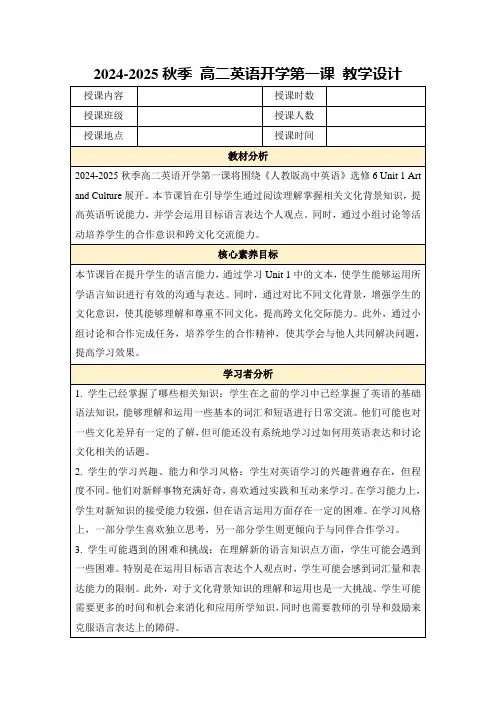
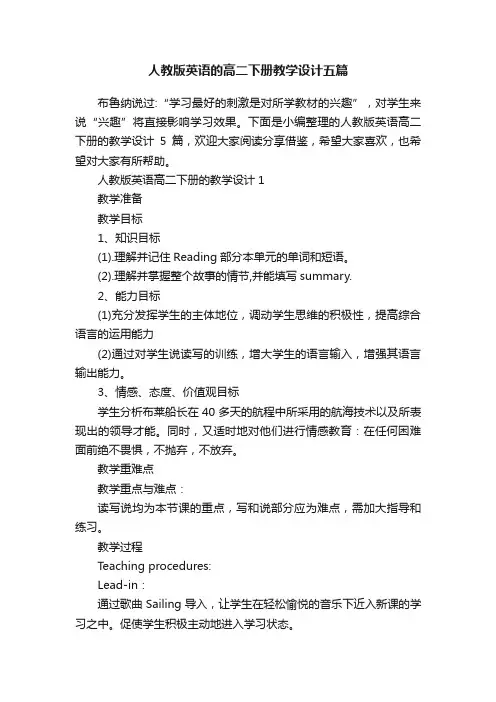
人教版英语的高二下册教学设计五篇布鲁纳说过:“学习最好的刺激是对所学教材的兴趣”,对学生来说“兴趣”将直接影响学习效果。
下面是小编整理的人教版英语高二下册的教学设计5篇,欢迎大家阅读分享借鉴,希望大家喜欢,也希望对大家有所帮助。
人教版英语高二下册的教学设计1教学准备教学目标1、知识目标(1).理解并记住Reading部分本单元的单词和短语。
(2).理解并掌握整个故事的情节,并能填写summary.2、能力目标(1)充分发挥学生的主体地位,调动学生思维的积极性,提高综合语言的运用能力(2)通过对学生说读写的训练,增大学生的语言输入,增强其语言输出能力。
3、情感、态度、价值观目标学生分析布莱船长在40多天的航程中所采用的航海技术以及所表现出的领导才能。
同时,又适时地对他们进行情感教育:在任何困难面前绝不畏惧,不抛弃,不放弃。
教学重难点教学重点与难点:读写说均为本节课的重点,写和说部分应为难点,需加大指导和练习。
教学过程Teaching procedures:Lead-in:通过歌曲Sailing导入,让学生在轻松愉悦的音乐下近入新课的学习之中。
促使学生积极主动地进入学习状态。
ComprehensionStep I Please Skim the passage and get the main idea.Step II. Scan the passage: True or False.1. I was forced to join Captain Bligh in the small boat.2. After the c rew took over the ship “Bounty”, Captain Bligh was allowed to take with him a chart , a compass and a quadrant.3. It was very difficult for us to get a correct reading from the quadrant as the boat moved constantly during the course.4. Captain Bligh used a system called “dead reckoning” and he knew there was land directly southwest of their original position.5. Captain Bligh was as weak as the rest of us but he was determined not to give up.6. Captain Bligh kept us busy and tried to take our minds off our stomachs and thirst all the way.7. We finally escaped the jaws of death and arrived in Timor over fifty days after being set loose in our small boat.Step III. Group work: further reading.When captain Blight returned home he was honored as a hero. Discuss in groups whether he should receive a special medal or not.Step IV. Affective educationAfter learning the text, as senior three students, what can we learn from Captain Blight in our life?Step V. Summary:I am _____ to have sailed with Captain Bligh on his journey of over40 days through about4,000 miles in an open boat ______the Pacific Ocean in 1789.In the beginning, on our ________(depart), some of the crew took _____theship and the captain ___________(deposit) into a smallboat. Thus we werecaught _____a dilemma. We decided to stick with him _______thick and thin though we seemed to face _____uncertaindeath.During the long and toughjourney, we encountered many unexpected hardships. Despite _____(lack) of foodand water, he kept us _______(occupy) and cheerful to take our minds ____troubles. All the way he taught us how to cope _______various situations. Finallythey arrived at Timor __________(success) andthey were honored as _______(hero).The story shows that one man’sspirit and his determinatio n should not ________ (defeat) by circumstances.Complexsentences(分析并翻译1-2个长难句)Challengeyourself!---Grammar Filling1. I’m proud to have sailed withCaptain Blight ____his journey of over 40 days _________about 4,000miles ____anopen small boat _______ the Pacific Ocean.2. On our _________(depart) from T ahiti, some crew took _____the ship. And those of us onboard ____________(catch) in a dilemma.3. As you can see from the map we kept_____a straight course pretty well.4. The captain kept us busy________ (read) the tables to work out our position .5. It was the extreme lack of waterthat was hard to cope with ______________ (psychology)6.He kept us busy and tried to take our minds课后习题Challenge yourself!---Grammar Filling1. I’m proud to have sailed with Captain Blight ____his journey of over 40 days _________about 4,000miles ____an opensmall boat _______ the Pacific Ocean.2. On our _________(depart) from T ahiti, some crew took _____the ship. And those of us on board ____________(catch) in a dilemma.3. As you can see from the map we kept _____a straight course pretty well.4. The captain kept us busy________ (read) the tables to work out our position .5. It was the extreme lack of water that was hard to cope with ______________ (psychology)6.He kept us busy and tried to take our minds _____our __________(stomach).人教版英语高二下册的教学设计2核心单词1. alternativen.可供选择的事物;(两者或以上)可能的选择adj. 供选择的, 二选一的常用结构:have no alternative but to do sth.只能做某事;除¡¡外别无选择We have no alternative but to go on.除了继续下去,我们别无选择。
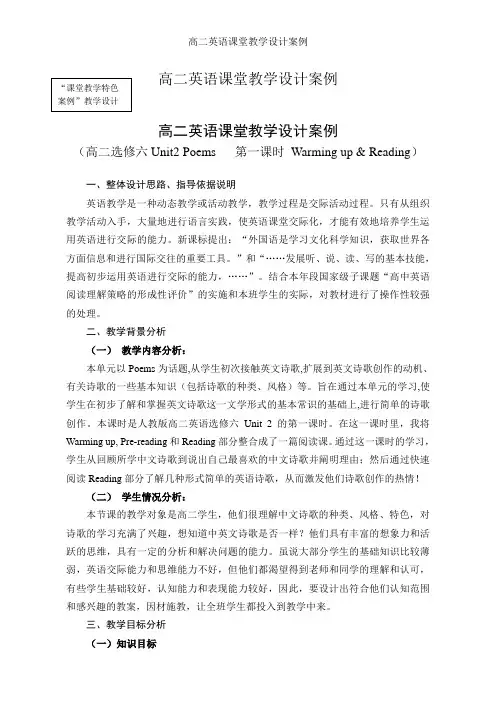
高二英语课堂教学设计案例高二英语课堂教学设计案例(高二选修六Unit2 Poems 第一课时Warming up & Reading)一、整体设计思路、指导依据说明英语教学是一种动态教学或活动教学,教学过程是交际活动过程。
只有从组织教学活动入手,大量地进行语言实践,使英语课堂交际化,才能有效地培养学生运用英语进行交际的能力。
新课标提出:“外国语是学习文化科学知识,获取世界各方面信息和进行国际交往的重要工具。
”和“……发展听、说、读、写的基本技能,提高初步运用英语进行交际的能力,……”。
结合本年段国家级子课题“高中英语阅读理解策略的形成性评价”的实施和本班学生的实际,对教材进行了操作性较强的处理。
二、教学背景分析(一)教学内容分析:本单元以Poems为话题,从学生初次接触英文诗歌,扩展到英文诗歌创作的动机、有关诗歌的一些基本知识(包括诗歌的种类、风格)等。
旨在通过本单元的学习,使学生在初步了解和掌握英文诗歌这一文学形式的基本常识的基础上,进行简单的诗歌创作。
本课时是人教版高二英语选修六Unit 2的第一课时。
在这一课时里,我将Warming up, Pre-reading和Reading部分整合成了一篇阅读课。
通过这一课时的学习,学生从回顾所学中文诗歌到说出自己最喜欢的中文诗歌并阐明理由;然后通过快速阅读Reading部分了解几种形式简单的英语诗歌,从而激发他们诗歌创作的热情!(二)学生情况分析:本节课的教学对象是高二学生,他们很理解中文诗歌的种类、风格、特色,对诗歌的学习充满了兴趣,想知道中英文诗歌是否一样?他们具有丰富的想象力和活跃的思维,具有一定的分析和解决问题的能力。
虽说大部分学生的基础知识比较薄弱,英语交际能力和思维能力不好,但他们都渴望得到老师和同学的理解和认可,有些学生基础较好,认知能力和表现能力较好,因此,要设计出符合他们认知范围和感兴趣的教案,因材施教,让全班学生都投入到教学中来。
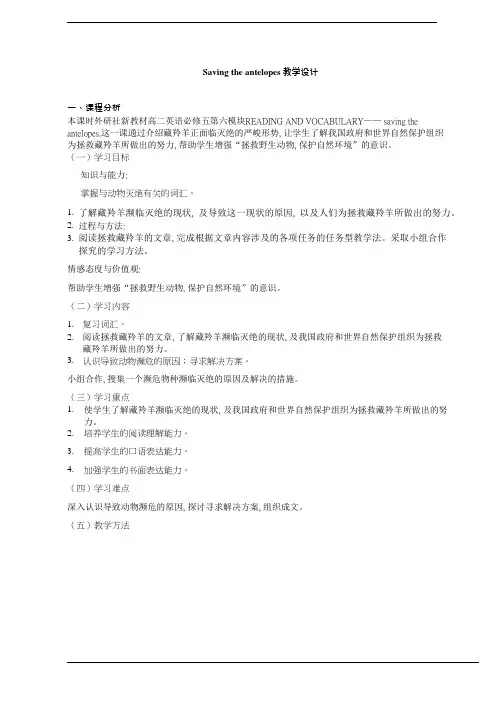
Saving the antelopes 教学设计一、课程分析本课时外研社新教材高二英语必修五第六模块READING AND VOCABULARY—— saving the antelopes.这一课通过介绍藏羚羊正面临灭绝的严峻形势, 让学生了解我国政府和世界自然保护组织为拯救藏羚羊所做出的努力, 帮助学生增强“拯救野生动物, 保护自然环境”的意识。
(一)学习目标知识与能力:掌握与动物灭绝有关的词汇。
1.了解藏羚羊濒临灭绝的现状, 及导致这一现状的原因, 以及人们为拯救藏羚羊所做出的努力。
2.过程与方法:3.阅读拯救藏羚羊的文章, 完成根据文章内容涉及的各项任务的任务型教学法。
采取小组合作探究的学习方法。
情感态度与价值观:帮助学生增强“拯救野生动物, 保护自然环境”的意识。
(二)学习内容1.复习词汇。
2.阅读拯救藏羚羊的文章, 了解藏羚羊濒临灭绝的现状, 及我国政府和世界自然保护组织为拯救藏羚羊所做出的努力。
3.认识导致动物濒危的原因;寻求解决方案。
小组合作, 搜集一个濒危物种濒临灭绝的原因及解决的措施。
(三)学习重点1.使学生了解藏羚羊濒临灭绝的现状, 及我国政府和世界自然保护组织为拯救藏羚羊所做出的努力。
2.培养学生的阅读理解能力。
3.提高学生的口语表达能力。
4.加强学生的书面表达能力。
(四)学习难点深入认识导致动物濒危的原因, 探讨寻求解决方案, 组织成文。
(五)教学方法本科课要运用了任务型教学法。
在具体操作中又采取了探究活动, 小组讨论, 合作学习等教学活动类型。
二、学情分析我们学校是农村普通高中。
班级的学生普遍存在英语基础差, 缺乏英语学习兴趣的问题。
作为农村高中, 因环境限制大多数学生的口头表达能力低且羞于开口, 需要教师的积极引导和归纳总结。
三、设计理念《英语课程标准》要求高中英语课程的设计与实施要有利于学生优化英语学习方式, 使他们通过观察、体验、探究等积极主动的学习方法, 充分发挥自己的学习潜能, 形成有效的学习策略, 提高自主学习的能力;要有利于学生学会运用各种信息资源, 拓宽学习渠道, 并形成具有个性的学习方法和风格。
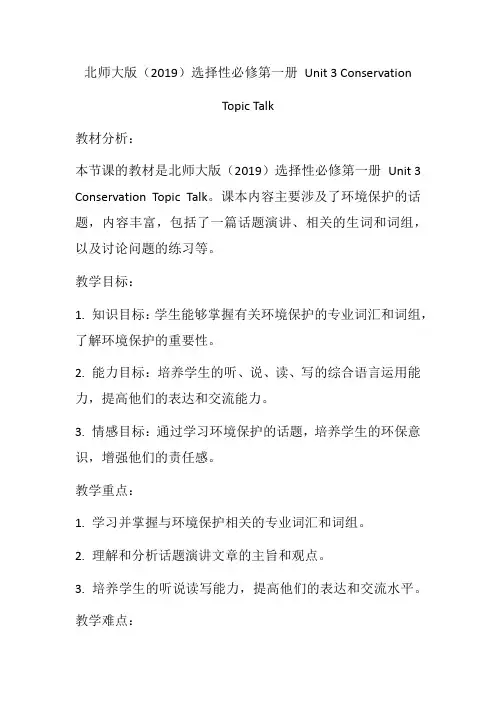
北师大版(2019)选择性必修第一册Unit 3 ConservationTopic Talk教材分析:本节课的教材是北师大版(2019)选择性必修第一册Unit 3 Conservation Topic Talk。
课本内容主要涉及了环境保护的话题,内容丰富,包括了一篇话题演讲、相关的生词和词组,以及讨论问题的练习等。
教学目标:1. 知识目标:学生能够掌握有关环境保护的专业词汇和词组,了解环境保护的重要性。
2. 能力目标:培养学生的听、说、读、写的综合语言运用能力,提高他们的表达和交流能力。
3. 情感目标:通过学习环境保护的话题,培养学生的环保意识,增强他们的责任感。
教学重点:1. 学习并掌握与环境保护相关的专业词汇和词组。
2. 理解和分析话题演讲文章的主旨和观点。
3. 培养学生的听说读写能力,提高他们的表达和交流水平。
教学难点:1. 提升学生的英语听和读的能力,使他们能够理解文章的主旨和观点。
2. 培养学生的写作能力,使他们能够准确、流畅地表达自己的思想。
学情分析:学生是高一年级的学生,具有一定的英语基础,能够较好地理解和运用英语。
但是他们对于环境保护的知识和专业术语可能不太熟悉,对于演讲文章的理解和写作能力有待提高。
教学策略:1. 激发学生学习兴趣:通过引入真实案例、音频和视频等多媒体素材,激发学生的学习兴趣,增强他们的学习动力。
2. 情景教学:通过模拟环境保护的实际场景,让学生在情境中体验,增强他们对环保的认识和理解。
3. 合作学习:通过小组讨论、合作学习等方式,培养学生的交流和合作能力,激发他们的团队合作精神。
教学方法:1. 预习导入:通过播放相关视频、展示环境保护图片等方式,引入环境保护话题,唤起学生的相关思维,激发学习兴趣。
2. 听说训练:通过播放录音材料和集体朗读的方式,训练学生的听说能力,提高他们对文章主旨和观点的理解。
3. 课堂练习与讨论:通过课后练习题和小组讨论的方式,巩固学生的学习成果,加深对专业术语和文章内容的理解。

课时教学设计本单元的主题是Relationships,本节课主要介绍人际关系之师生关系。
【What】本节课是本单元第一课第一课时,包含两篇记叙文的阅读。
分别从教师和学生的视角讲述了他们对彼此的印象,回忆了两个人之间的故事。
第一篇是学生Graham 介绍了自己初识教师时的学习状况——lazy, boring, lack confidence, didn’t want to know,生动描述了Mr. Jenkins 独特的教学风格——interesting, let me pour, ask me to give a presentation, 使他发生了巨大的变化,最终成为成功人士的故事。
第二篇是Mr. Jenkins 回忆了对学生Graham 的初始印象和与其相处的点点滴滴,并阐述了自己对教育事业的认识——教师职业虽有压力却值得用心付出的事业。
【Why】语篇旨在让学生通过阅读两篇文章,对比Graham 前后的变化,由之前的懒惰,不爱学习,对科学毫无兴趣,到后来的充满自信,热爱科学,通过分析推断学生成功的原因源于教师,让学生能够认识到教师对学生的重要影响,体会到对教师的感恩,并形成对良好师生关系重要意义的认识,从而提高学生对人际交往的认识,形成正确的人生观、价值观。
【How】本文从一师一生两个视角记叙了一段过往师生情,采用了对比的手法呈现了一位好教师和好的教育方法对一名学生的重要性。
两篇文章均配有说明性的图片,并以第一人称进行叙述,增加了语言的真实性,让学生有很强的带入感。
第一篇以学生视角叙述,语言简单,为学生所熟悉,易于理解;第二篇以教师视角叙述,谈及教育理念语言相对较难理解。
但本篇记叙文的文体,情节生动,选词地道,逻辑性强,总体上适合高二学生的水平。
Teaching Presentation forLesson 1 Unit 1 Teachers望江中学方玲Ⅰ. Greetings and introduction:1.Guiding theory2.general introduction3.teaching procedures4.teaching reflectionⅡ. Explanations1. Guiding theory: New English Curriculum standard, the English keypetence and Bloom’s taxonomy.2. General introduction: analysis of teaching material and students, teaching objectives, teaching focus and difficulties, teachingapproaches and learning methods.Ш. The analysis of the teaching material1.The thematic context:human and society.2.The big idea: interpersonal relationship.3.The small idea: teacherstudent relationship.4. Features: interlinked, conneted to people’s life and inform ative.5. Purpose:Students will gain the ability to build a good relationship withpeople after learning it.The analysis of the textWhat The topic is the relationship between teacher and student.Passage1 aims to emphasize Mr. Jenkins’ great influence onGraham.Passage 2 mainly talks about Mr. Jenkins’ beliefs in tea ching. Why to understand the importance of a good teacherstudent relationship and improve the awareness of interpersonal munication.How This text is narration which shows the importance of a goodteacher and good teaching methods to a student by contrasting anddescribing.Analysis of the students1. Students have the ability to acquire detailed information by skimmingand scanning. They also have mastered some vocabulary.2. Students are weak in knowledge integration and logicalreasoning;students lack profound cognition of the influence ofteacherstudent relationship on individuals.Analysis of the teaching objectivesTheoretical base: the core petences of English subjectnguage ability: to summarize the reading details about theGraham’s change and Mr Jenkins’ impression of Graham as well ashis beliefs in teaching.2.Thinking capacity: students’logical reasoning, summarizing abilityand critical thinking ability will be improved.3.Cultural awareness: to understand teachers’ great influence on studentand the importance of building a harmonious and fortablerelationship with their teachers.4.Learning ability: autonomous learning ability, cooperative learningability and inquiry based learning abilityTeaching focus and difficultiesAmong the four teaching objectives, No.1 and No.2 are teaching focus;No.3 and No.4 are teaching difficulties.Teaching approaches and learning methodsThe teaching approaches: PWP approach, Activitybased approach andmunicative language approach.The learning methods: Activitylearning, Cooperative learning andinquiry language learning.Teaching proceduresIn order to achieve the teaching objectives mentioned above, theteaching procedure is divided into 5 steps.Step 1 Leadin1.play a guessing game with students to introduce the topic2.show students some photos to describe a good teacher’s persona lities.The purpose is to activate students’ background knowledge and makeconnections between existing and new knowledge.Step 2 PrereadingFollowed by the question in the leadin part, the same question is given to students to predict the text. “What kind of teacher do you think Mr Jenkins is ?”Purpose:To develop students’predictive skills and arouse students’great interest in reading the passages.Step 3 WhilereadingActivity3 Skim & checkStudents skim the passages, check their prediction and figure out the genre of the passage as well as the 6 elements of a narrative.Purpose:Get to know the genre of the article and s tudents’ ability of fast reading could be enhanced.Activity4 Scan & acquireStudents are divided into 2 groups and one group read one passage to acquire the detailed information about what was Graham like before and after attending Mr Jenkins’class ; students exchange to read the other passage and add more information for each other.Purpose: To acquire detailed information and cultivate students cooperative learning.Activity 5 Explore & understandExplore why and how Graham has changed and conclude that Mr.Jenkins’ teaching methods, teaching beliefs and teaching attitudes mainly contribute to Graham’s succ ess.Purpose: To deeply understand the text ; students’logical reasoning and summarizing ability could be enhanced.Step 4 PostreadingActivity 6 Explore & ThinkStudents learn to summarize the main features of a narrative and think about one more question: what’s the purpose of writing a narrative. Students discuss with each other and figure out the answerto express a character’s feeling and personality. And then I follow up on the question: what feelings have been expressed in the text?Purpose: To get to know the purpose of writing a narrative and get closer to the theme of the story.Activity 7 Express & TalkStudents have a group work to share a story about their beloved teacher and express their love for the teacher. the other students to make a group evaluation for the storyteller to evaluate what they learned in class. Purpose: students can consolidate and internalize what they learned in class and transfer reading to speaking and talking. Students’ speaking ability can be improved and moral value can be enhanced.Activity 8 Appreciate & FeelShow students some impressive pictures to realize the great importance of respecting teachers and valuing education. Besides, make a short video with the photos of all students to show love. Then students can feel love and recognize love is what keeps a bidirectional relationship going.Purpose: In order to better understand the theme of this lesson, and to cultivate the students’ good quality.Step 5 AssignmentThe assignment includes two parts. One is required, which is to pave way for next period and the other is optional but meaningful.Purpose: To transfer and innovate the knowledge learned in class. Students can feel the friendship and cherish the time with teachers. Also, the assignment can arouse students’ desire to study hard and gratitude to teachers.Blackboard designThe blackboard design is the production of whole lesson. It looks like a pyramid, which shows what makes a s tudent’s success and what makes a good teacher . It also shows a good relationship is the foundation of a person’s success .Purpose: Students can deeply and vividly understand the theme of the passage .Teaching reflection1.The topic of this lesson is the teacherstudent relationship that is closely related to students. In class, students and teachers can easily empathize with each other.2.The objectives have been attained and students are fully involved. But one period is not enough to read the text more intensively. How to improve the deep understanding of the text in a more effective and feasible way of teaching will be explored.。
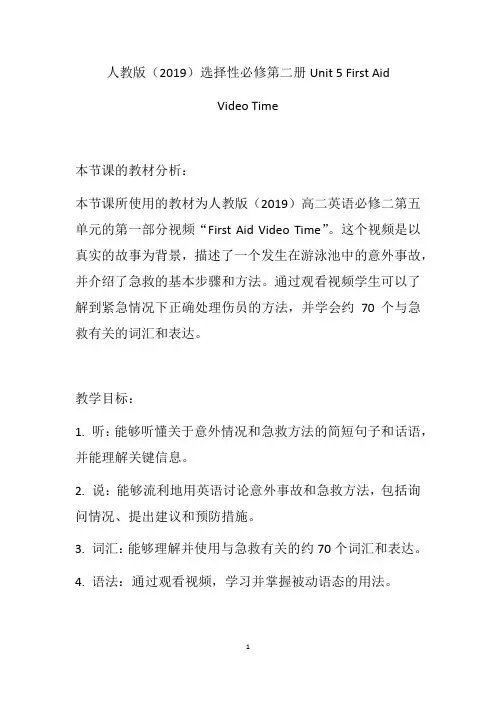
人教版(2019)选择性必修第二册Unit 5 First AidVideo Time本节课的教材分析:本节课所使用的教材为人教版(2019)高二英语必修二第五单元的第一部分视频“First Aid Video Time”。
这个视频是以真实的故事为背景,描述了一个发生在游泳池中的意外事故,并介绍了急救的基本步骤和方法。
通过观看视频学生可以了解到紧急情况下正确处理伤员的方法,并学会约70个与急救有关的词汇和表达。
教学目标:1. 听:能够听懂关于意外情况和急救方法的简短句子和话语,并能理解关键信息。
2. 说:能够流利地用英语讨论意外事故和急救方法,包括询问情况、提出建议和预防措施。
3. 词汇:能够理解并使用与急救有关的约70个词汇和表达。
4. 语法:通过观看视频,学习并掌握被动语态的用法。
教学重点:1. 学习和使用与急救有关的词汇和表达。
2. 学习被动语态的用法。
3. 学习和理解关于意外情况和急救方法的简短句子和话语。
教学难点:如何让学生掌握并运用被动语态的用法。
学情分析:学生是高二的学生,具备一定的英语基础。
但是对于急救这一主题,学生可能没有太多的了解和经验。
他们在学习时可能会遇到词汇量较大、语法难度较高的问题。
此外,学生的听力能力和口语表达能力也需要进一步培养。
教学策略:1. 激发学生兴趣:通过引入真实故事、视频和图片等多种教学资源,激发学生对急救话题的兴趣,增加学习的积极性。
2. 提供合作学习机会:结合小组活动和角色扮演等形式,让学生在实践中提高听说能力,并培养合作意识和团队精神。
3. 引导学生自主学习:提供相关词汇和语法的学习材料和渠道,鼓励学生自主学习和探索,从而更好地掌握知识。
教学方法:1. 视听法:通过观看视频和听力材料,让学生感受真实情境,提高听力理解能力。
2. 互动式教学法:通过学生合作讨论和小组角色扮演等形式,让学生积极参与,提高口语表达能力。
3. 自主学习法:鼓励学生利用网络、课外阅读等渠道自主学习相关词汇和语法知识,提升学习效果。
北师大版(2019)选择性必修第二册Unit 5 EducationLesson 3 Understanding教材分析:《北师大版(2019)选择性必修第二册Unit 5 Education Lesson 3 Understanding》是高二英语教材中的一节课程。
此课程主要围绕“理解教育”的主题展开,通过阅读和讨论,让学生了解不同教育观念和家庭教育的重要性。
教学目标:1. 语言目标:学习并掌握与教育相关的词汇和表达方式,提高学生的英语听、说、读、写的能力。
2. 知识目标:了解不同的教育观念,并能从中获取对教育的深刻理解。
3. 能力目标:培养学生的阅读理解和讨论的能力,学会表达自己对教育的看法。
教学重点:1. 掌握课文中的关键词汇和句子结构。
2. 理解不同的教育观念及其对学生的影响。
教学难点:1. 理解并归纳整个课文的主旨和观点。
2. 练习表达自己对教育的看法,并与其他同学讨论和交流。
学情分析:学生为高二学生,对英语掌握了一定的基础知识和语言技能。
学生的阅读理解能力相对较强,但对于抽象概念的理解和表达能力还有待提高。
另外,学生对于自己的教育问题和家庭教育的重要性有一定的认知。
教学策略:1. 提供足够的语言输入,如课文的朗读和解释,并重点向学生介绍和讨论课文中的关键词汇和句子结构。
2. 引导学生进行小组或全班讨论,让学生能够表达自己的观点,并听取他人观点,加深对教育的理解。
3. 提供适当的练习和任务,如阅读理解题、填写表格、写作练习等,以巩固学生的知识和能力。
教学方法:1. 预测法:通过看图和标题,让学生猜测课文内容,激发学生的学习兴趣。
2. 合作学习法:将学生分成小组,让学生在小组内讨论和交流自己对教育的理解和观点,并展示给其他同学。
3. 提问法:通过提问来引导学生思考,加深对课文的理解。
4. 情景教学法:通过小组或全班讨论,将课文中的教育观点与学生的现实生活结合起来,增加学生的学习体验。
导入环节(约5分钟):导入环节的目的是引起学生的兴趣,并激发他们对本课主题的思考和讨论。
北师大版(2019)选择性必修第二册Unit 5 EducationLesson 2 The Objectives of Education教材分析:本节课的教材来源于北师大版(2019)选择性必修第二册Unit 5 Education Lesson 2 The Objectives of Education。
该教材主要围绕教育的目标展开,通过对不同观点的探讨和辩论,引导学生思考教育的重要性和目标的多样性。
教材内容丰富,包括阅读理解、课文分析、辩论讨论等,能够激发学生的学习兴趣,并培养其阅读、思考和辩论的能力。
教学目标:1. 知识与能力目标:理解并掌握与教育目标相关的词汇和表达方式;能够理解并分析不同的教育目标观点。
2. 过程与方法目标:培养学生积极思考和参与问题讨论的能力;提高学生的阅读理解能力和口语表达能力。
3. 情感态度与价值观目标:培养学生尊重多样性、包容不同观点的价值观;增强学生对教育的重要性的认识。
教学重点:1. 学习掌握与教育目标相关的词汇和表达方式。
2. 理解课文内容,分析不同的教育目标观点。
3. 培养学生的阅读理解能力和口语表达能力。
教学难点:1. 学生可能对某些生僻词汇和抽象概念不太熟悉,理解课文可能存在困难。
2. 学生在辩论讨论环节可能会遇到表达不清晰、思维不够开放等问题。
学情分析:学生为高二年级学生,对英语的基础知识和语言技能已有一定掌握。
但由于学生年龄较小,对于一些抽象的概念和复杂的语言表达可能存在一定困难。
另外,学生的思维习惯和表达能力也相对有限,需要通过多种激发兴趣和培养能力的教学策略和方法进行指导。
教学策略:1. 激发兴趣:通过提问、展示图片等方式激发学生的学习兴趣,并调动学生参与讨论的积极性。
2. 合作学习:设置小组活动,让学生在小组内进行合作讨论和辩论,增强学生的参与感和合作能力。
3. 多媒体辅助教学:利用多媒体教具、幻灯片等辅助教学手段,帮助学生更直观地理解课文内容,提高学习效果。
高二英语新教材下册〔Unit12 Fact andFantasy〕-教学教案1.When do you think the inventions in the pictures above were made(火车,电灯和蒸汽船)2.When was electricity discovered and how was it used in the following two hundred years3.In the early nineteenth century, people had no idea what the inside of the earth might look like. Can you explain what we know about it today4.Write down eight key words that you expect to find in the reading passage below.Jules Verne was born in 1828, in France. His father sent him to Paris to study law, but instead Verne developed his love for the theatre. To make a living, Verne had to write and sell stories. Jules spent many hours in Paris libraries studying geology, physics and many other subjects. Heused the latest ideas and technical inventions of his day in his books. Many of the instruments in his novels will remind the reader of Dr Benjamin Franklin’s experiments with electricity. By taking the scientific developments of his day one step further, Jules Verne laid the foundation of modern science fiction. He also suggested how inventions could be used in the future to allow man to do things that were considered impossible in his own time. Jules Verne died in 1905, long before any of his dreams came true.At the beginning ofPOST-READING1.Describe the character of Captain Nemo.2.Paraphrase the following sentences or parts of sentences using your own words.1.)To make a living he had to write and sell stories.。
一、教学目标1. 知识目标:(1)掌握生词和短语,如:inhabitant, explore, ancient, mystery, etc.(2)理解文章大意,把握文章结构,提高阅读理解能力。
(3)了解美洲印第安文明,拓宽知识面。
2. 能力目标:(1)提高学生的阅读速度和准确性。
(2)培养学生对英语阅读的兴趣和自主学习能力。
(3)提高学生的口语表达能力,能够用英语讨论文章内容。
3. 情感目标:(1)激发学生对美洲印第安文明的兴趣,培养民族自豪感。
(2)培养学生对探险精神的敬佩,树立积极向上的生活态度。
二、教学重难点1. 教学重点:(1)掌握生词和短语。
(2)理解文章大意,把握文章结构。
(3)提高阅读速度和准确性。
2. 教学难点:(1)分析文章结构,归纳段落大意。
(2)用英语讨论文章内容,提高口语表达能力。
三、教学过程1. 导入新课(1)教师简要介绍美洲印第安文明,激发学生学习兴趣。
(2)展示相关图片,引导学生思考:为何要探索美洲印第安文明?2. 预习课文(1)学生自读课文,掌握生词和短语。
(2)教师检查预习情况,解答学生疑问。
3. 课堂讲解(1)教师引导学生分析文章结构,归纳段落大意。
(2)讲解重点词汇和短语,帮助学生理解文章内容。
(3)引导学生思考文章中的问题,如:探险队为何要寻找失落的城市?失落的城市有何特殊之处?4. 阅读练习(1)教师布置阅读练习,如:填空、选择题等。
(2)学生独立完成练习,教师巡视指导。
5. 口语练习(1)学生分组讨论文章内容,用英语表达自己的观点。
(2)教师巡视指导,纠正发音和语法错误。
6. 总结与拓展(1)教师总结本节课所学内容,强调重点词汇和短语。
(2)布置课后作业,如:写一篇关于探险的文章,要求学生用英语表达。
四、教学反思本节课通过阅读文章,让学生了解美洲印第安文明,提高学生的阅读理解能力和口语表达能力。
在教学过程中,教师应注重以下几点:1. 营造轻松愉快的课堂氛围,激发学生的学习兴趣。
北师大版(2019)选择性必修第一册Unit 3 ConservationReading Club本节课教材分析:本节课的教材为北师大版(2019)选择性必修第一册Unit 3 Conservation Reading Club,主要内容包括保护野生动物、野生动物的生存环境、动植物皮毛的用途以及我们应该如何保护野生动物等。
教学目标:1. 语言目标:学生能够运用英语表达关于保护野生动物的观点和观念。
2. 沟通目标:学生能够就保护野生动物的重要性进行交流和讨论。
3. 学习技能:学生能够提取阅读材料的关键信息,并进行阅读理解和写作练习。
教学重点:1. 学生能够理解并运用课文中关于保护野生动物的词汇和语法。
2. 学生能够从阅读材料中提取关键信息,进行阅读理解。
教学难点:1. 学生能够运用所学知识和语言进行交流,表达自己的观点和观念。
2. 学生能够理解并运用课文中较难的词汇和句式。
学情分析:学生是高一学生,英语水平相对较低,对于保护野生动物可能了解不多,也缺乏相关的词汇和语法知识。
此外,学生的阅读理解能力和写作能力也还需要提高。
因此,在教学过程中需要注重培养学生的语言运用能力、沟通能力和阅读理解能力。
教学策略:1. 激发学生的学习兴趣,通过展示有关野生动物保护的图片和视频来引导学生思考和讨论。
2. 创设真实情境,让学生参与到保护野生动物的讨论和问题解决中,提高学生的主动学习和动手能力。
3. 引导学生运用所学的语言知识和技能进行口头交流和写作练习。
教学方法:1. 任务型教学法:通过完成一系列的任务和活动,培养学生的语言运用能力和沟通能力。
2. 合作学习法:组织学生进行小组讨论和合作活动,提高学生的合作意识和团队精神。
3. 情景教学法:通过创设真实情境,激发学生的学习兴趣和动机,提高学生的学习效果。
4. 多媒体辅助教学法:利用多媒体资源,如图片、视频等辅助教学,提高学生的学习效果和理解能力。
导入环节(约5分钟)教学内容:1. 导入学生对保护自然和环境的认识和观点。
高二英语课堂教学设计案例(高二选修六Unit2 Poems 第一课时Warmingup &Reading)一、整体设计思路、指导依据说明英语教学是一种动态教学或活动教学,教学过程是交际活动过程。
只有从组织教学活动入手,大量地进行语言实践,使英语课堂交际化,才能有效地培养学生运用英语进行交际的能力。
新课标提出:“外国语是学习文化科学知识,获取世界各方面信息和进行国际交往的重要工具。
”和“……发展听、说、读、写的基本技能,提高初步运用英语进行交际的能力,……”。
结合本年段国家级子课题“高中英语阅读理解策略的形成性评价”的实施和本班学生的实际,对教材进行了操作性较强的处理。
二、教学背景分析(一)教学内容分析:本单元以Poems为话题,从学生初次接触英文诗歌,扩展到英文诗歌创作的动机、有关诗歌的一些基本知识(包括诗歌的种类、风格)等。
旨在通过本单元的学习,使学生在初步了解和掌握英文诗歌这一文学形式的基本常识的基础上,进行简单的诗歌创作。
本课时是人教版高二英语选修六Unit2的第一课时。
在这一课时里,我将Warming up,Pre-reading和Reading部分整合成了一篇阅读课。
通过这一课时的学习,学生从回顾所学中文诗歌到说出自己最喜欢的中文诗歌并阐明理由;然后通过快速阅读Reading部分了解几种形式简单的英语诗歌,从而激发他们诗歌创作的热情!(二)学生情况分析:本节课的教学对象是高二学生,他们很理解中文诗歌的种类、风格、特色,对诗歌的学习充满了兴趣,想知道中英文诗歌是否一样?他们具有丰富的想象力和活跃的思维,具有一定的分析和解决问题的能力。
虽说大部分学生的基础知识比较薄弱,英语交际能力和思维能力不好,但他们都渴望得到老师和同学的理解和认可,有些学生基础较好,认知能力和表现能力较好,因此,要设计出符合他们认知范围和感兴趣的教案,因材施教,让全班学生都投入到教学中来。
三、教学目标分析(一)知识目标理解并能熟练运用本文中的重点词汇和句型。
1、重点词汇poem, recite,aspect, rhyme, rhythm,nursery rhyme,diamond, endless,branch,translation, transform, joy, anger, make up of, in particular, eventually, take it easy, runout of, contradictory.2、重点句型Some poemstell a storyor.... Others......They delight small childrenbecause...….Withso manydifferent forms of poetry tochoosefrom…(二) 能力目标1、能够熟练的掌握本课内容,用所学句型,进行交流。
让学生在特定的情境下运用所学的知识,培养学生实际运用英语的能力。
2、要求学生找出文章的主题, 列举文中介绍的五种诗歌形式,用自己的语言讲述文中几首诗歌的主题,找出两首节奏强的诗歌,击掌诵读,并圈出押韵词.3、体会自己喜欢的诗歌的内涵,并阐明理由,模仿作英文诗.(三)情感目标1、让学生在课堂中轻松的学习,提高学生的观察力,欣赏能力以及学会利用多种手段培养学生的自主学习的能力。
2、激发学生学习英语的兴趣,培养他们英语学习的积极态度,使他们建立学习英语的自信。
四、教学重点、难点分析(一)教学重点:1. Master the importantwords, phrasesand sentences patterns.2.Collect thereasonswhy thepoets write poems.3. The similarities and differences between theChinese andEnglishpoetsand poems.(二)教学难点:1.Find out the characteristics of eachkind of poems.2.Practice writingsimple poems.五、教学过程设计Step1 Leading inEnjoy a piece of music.(水调歌头)设计意图:通过欣赏这首由诗歌改编成的歌曲,不仅活跃了课堂气氛,而且创设了良好的学习气氛,激发了学生的学习兴趣,在课的一开始就把学生的注意力全部吸引过来了,也很自然的导入到了下一个教学步骤。
Step2:WarmingupTask1 1.By enjoying the music, ask students totalk about the ir favoriteChinesepoems.“Do you like poems?Whichone is your favorite? Why do you like it best?”设计意图:运用问题式教学,通过对自己最喜欢的中文诗歌的回顾,引发学生对英文诗歌的向往。
让学生提前进入诗的海洋。
2.Show some Englishpoems.设计意图:从几首简单的唐诗的译文到韵律比较强的Little star,再到复杂的莎士比亚的十四行诗,让学生从易到难的了解英语诗歌。
同时通过朗读这些英语诗歌,让学生清楚rhyme和rhythm在英语诗歌中的重要性,也为后面的阅读教学打下基础。
Step3:Pre-readingTask2Askthe students to skim the poemsintheRea dingand answerthe questions. Then tick the box.(P9)Questions:How many kindsof poems does the text mention?What arethey?设计意图:运用任务型教学法与合作学习方法让学生以小组的形式完成这一任务。
并指导学生在阅读中的一些关于跳读的技巧。
Step4:ReadingAskthestudents to read thepassage carefully and finishthe tasks one by one.Task3Nursery rhymes童谣1.Playthe video(PoemA)设计意图:通过视频的播放,教师能向学生很直观形象地展示diamond ring ,b rass, billy-goatetc.本单元的生词,并激发学生的学习兴趣。
2. Askandanswer:Questions: (1)Ifthat looking-glass gets broken,what’s papa going to buy?(2) If that billy-goat runs away, what’spapa going to buy?设计意图:童谣简洁明快,具有重复性,易记忆。
所以通过听力训练,学生能很快回答出问题。
3.Enjoy another nursery rhyme设计意图:播放另一首童谣,指导学生总结童谣的特点并打出节拍,了解诗歌的节奏。
Task4 List poems 清单诗(PoemB&C)1. Ask the studentstoread Poem B and PoemC, and summarize the features of listpoems.设计意图:因为学生对清单诗比较熟悉,所以在学习这两首诗时,重点应该是通过对比这两首诗让学生了解清单诗的特点。
2. Letstudentsread another list poemloudly.(To my parents, tha nk you!)设计意图:通过读这首诗,让学生进一步了解清单诗,可以说是上一步的延续。
更重要的是,这首诗可以让学生体会到父母对我们的爱,让他们知道要感激父母。
在英语课中进行思想品德教育。
Task5 Cinquain五行诗(PoemD&E)1. Ask thestudentstoread two poems together.2. Helpthe studentsfind thetopic ofeach poem and summarizethe features ofCinquain line by line.设计意图:五行诗很简单,读起来很有趣。
学习这类诗歌主要是要让学生知道每一首诗的主题和这类诗歌的特点,每一行有几个词,词性是什么,说的内容是什么。
所以在教授这类诗歌时,重点是鼓励并帮助学生通过读和观察来总结五行诗的特点,并为后面的诗歌写作打基础。
Task6Haiku俳句诗(PoemF&G)1.Let thestudents listento the tape andclosetheireyes enjoying them.Justimaginethebeautifulscene and en couragethemto describe the scene.2. Summarize the feature:How many syllables are there in the Ha iku?设计意图:俳句诗是流行于日本的一种诗歌,学生不大熟悉,因此,对这类诗歌,学生了解一下就行了。
在教学过程中,我安排学生听录音想情景,不仅训练了学生的听力,还提高了学生的兴趣和审美能力。
Task7Tang poems唐诗(PoemH)Ask a girl to read the poemwith emotions,and othersjustenjoy it.Then answer the questions:Whatfeelingsthatyout hink the womanin thepoemhas?设计意图:学生对唐诗很熟悉,所以,对这类诗,我们可以通过欣赏来体会诗歌中人物的思想感情,从而加深对诗歌深层次的理解。
学生通过对这五种诗歌的学习,应该对简单的英语诗歌有所了解,也对英语诗歌越来越感兴趣了。
在整个Reading的教学过程中,我们对不同的诗歌种类采用不同的教学方法,有的放矢的进行教学,不仅提高了学生的学习兴趣,也训练了学生听、说、读、写各方面的能力。
Step5:DiscussionTask8Ask students to discuss in groups:Why do people write poems?设计意图:通过这样一个讨论,学生对诗歌的认识又上了一个新的台阶,进一步激发了他们的创作欲望,为下一步作铺垫。
Step6:PracticeTask91. Encourage studentstocreat theirCinquaintogether.2. Sharetheirpoems.附:学生的作品: 教师的作品:Teachers StudentsKnowledgeable,unselfish Energetic, lovelyUnderstanding,caring, guiding Teasing,learning,progres singThe ones we respestPassion and creation Forever Mine设计意图:这是这节课的一个升华,学生运用前面所学知识,进行发挥创作。